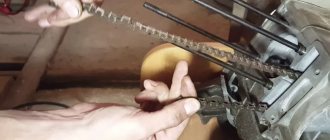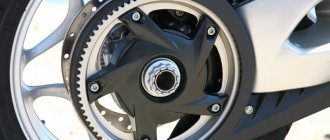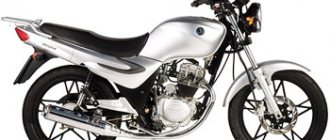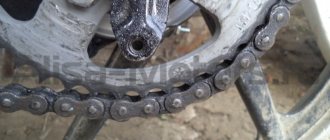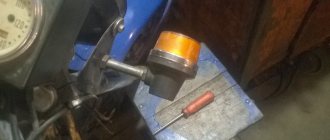RU-MOTO rating
- Reliability
- Chassis
- Appearance
- Comfort
4.3
Verdict
The Yamaha TDM 850 is perfect for experienced drivers and those who are already familiar with similar equipment. This is a truly versatile motorcycle.
Yamaha TDM850 - first introduced to a wide audience in 1991. In 2001, Yamaha discontinued the 850cc TDM and began producing the 900cc TDM. This review will focus on the 850 cc version. The TDM 850 is a versatile bike.
The new machine from Yamaha made a splash all over the world.
The new machine from Yamaha made a splash all over the world.
The new machine from Yamaha made a splash all over the world.
The first generation of TDM was released in 1991 and was produced until 1995, and sales of the device began almost simultaneously both in Japan and in Europe and North America. The device was equipped with an in-line twin with five-valve cylinder heads, simultaneous up-down movement of the pistons and alternating stroke. In this sense, the engine resembled a boxer engine familiar to many, where the pistons also move synchronously. The engine at that time was no longer a new product. Since 1989, it has been installed on production XTZ750 Super Tenere and has already won the Paris-Dakar race several times. For the new TDM, the cylinder diameter and piston stroke were increased (from 87x63 to 89.5x67.5), thereby increasing the engine displacement by 100 cm3 and power from 70 hp. at 7200 rpm up to 77 hp. at 7500 rpm. Torque also increased from 68 Nm at 6750 rpm (for the XTZ750) to 75.5 Nm at 6000 rpm. Of course, changes were also made to the transmission. The first two gears were made “shorter”, which ensured more dynamic acceleration, but gears 3–5 were “lengthened” in accordance with the asphalt orientation of the motorcycle.
Two wheels for all occasions
It would seem - what’s so difficult about making a motorcycle that is equally well suited for all purposes? The reasons for this are mainly commercial. Chopper riders do not need a high maximum speed; for fans of sport bikes, dynamics and maneuverability are more important than comfort; long-distance bikers are proud of the unpretentiousness of their touring enduro bikes. The Yamaha TDM 850 partly combines a little bit of everything. The design was original and somewhat controversial, but very successful. The Yamaha TDM 850 was produced for 10 years, having undergone one restyling during this time and receiving a lot of minor improvements.
The Japanese managed to cross a snake with a hedgehog and, with the TDM 850, get a motorcycle that can now be called a crossover. It is not suitable for conquering deserts and swamps, but it can overcome huge distances on broken roads, including dirt roads, with relative comfort and at an affordable price. Now the Yamaha TDM 850 on the secondary market is very cheap, comparable to some 20-year-old “400”. Why not? The maximum speed of the TDM 850 exceeds 200 km/h (but this also depends on the body kit and condition of the motorcycle), the gas tank holds 18-20 liters (depending on the generation), and acceleration from 0 to 100 km/h on a working bike is possible in 3. 8 seconds. Impressive even by modern standards, but the first Yamaha TDM 850 went on sale back in 1991, when the USSR was bursting at the seams and falling apart. At the same time, many copies are still in use, and with proper care they will last for another couple of decades.
Why is the Yamaha TDM 850 so loved? For a large range, excellent maneuverability, a good level of comfort, maintainability and overall endurance. The design of the first generation was quite controversial, many considered it outdated even at the time of its release, but in 1996 the production of the second generation TDM 850 began. The appearance turned out to be successful, and it went almost unchanged to its successor, the TDM 900, which was produced later, in 00s. However, Yamaha still couldn’t manage to make a universal motorcycle with impunity, so there was a fly in the ointment.
The second version of TDM has become smoother on the outside and “V-shaped” on the inside.
The second version of TDM has become smoother on the outside and “V-shaped” on the inside.
The second version of TDM has become smoother on the outside and “V-shaped” on the inside.
This engine is one of the champions in “eating” oil. Even a completely serviceable vehicle can consume up to 200 grams per 1000 km, let alone equipment that is approaching 20 years old! This is due to both the large number of valves and the liner design of the cylinders. Despite its high reliability, the main guarantee of the durability of the CPG is proper running-in, which in most cases neither Japanese nor European riders have even heard of. We also note the rather soft metal of the oil scraper rings, which wear out much faster than compression rings. So if the TDM oil appetite begins to approach “a liter per thousand”, it’s worth considering repairs. Simply replacing the valve stem seals will most likely not give the desired results. Most often, it is the rings that are to blame for increased oil consumption. Unfortunately, it is impossible to buy oil scraper rings separately, and a full set of rings for both pistons will cost about 3,500 rubles. Compression rings should be changed only if they are significantly worn, when the gap in the ring locks exceeds 0.7 mm - and take a closer look at the cylinder.
Owner reviews
Owners of this versatile bike tend to believe that this motorcycle is great for both beginners and more experienced riders. In any case, Yamaha is bought by those who are familiar with this technology and know all the features of its behavior on the road and beyond.
Proper care and optimal driving will contribute to long and trouble-free engine operation. In general, the motorcycle is easy to maintain, does not require major repairs and pleases its owner with its playful behavior. Experienced users note that the TDM850 can easily be ridden for several tens of thousands of kilometers, while the bike remains in excellent condition.
“Overall, the Yamaha TDM850 is not bad for long trips. This motorcycle is also well suited for riding in city traffic. Like any bike, it requires timely attention - otherwise you can expect unpleasant surprises in the form of excessive oil consumption. Nevertheless, even very experienced drivers who have been in the saddle for many seasons are happy to purchase this device.”
Owner's review of TDM 850 No. 1. Screenshot from the portal my.auto.ru
Read other motorcycle reviews The best bikes of 2014
Owner's review of TDM 850 No. 2.
Pros and cons from a motorcycle owner.
Real owner review No. 3.
Review #4.
Pros and cons of the Ymaha TDM 850 motorcycle according to one of the owners.
200912151933_5
If this is not possible, then you should agree with the seller so that he does not warm up the device before the meeting, and look at the cold start with your own eyes. Black smoke from a newly started engine is a bad sign. By the way, a cold start can also tell you about the motorcycle’s oil appetite. The “push-pull” smell of burnt oil from the pipe should be very alarming. After the engine has warmed up, hold a piece of paper or a napkin to the exhaust pipe and rev it up properly. A spot of black soot on paper is a bad sign, and if individual black splashes are visible, it’s a bad sign.
Tuning
The direction of tuning and how much a sports motorcycle costs after the changes made completely depend on the tasks and goals that the owner of the car sets for the studio. The basic set for models that will be used as urban transport for daily use is very banal and minimal: sliders and arches, costing from 3 to 7 thousand rubles, increase safety and allow you to protect the motorcycle in the event of a collision or fall. The bars installed on the Yamaha TRX 850 are not only effective, but also fit harmoniously into the overall design. Branded direct-flow mufflers will cost 20-40 thousand rubles, third-party manufacturers - at least 12 thousand rubles.
In European countries, the Yamaha TRX 850 is mainly purchased for creating street fighters. Motorists operating in this direction replace the sprockets, which allows them to change the gear ratio, and install more suitable brake pads. The engine's oil tank is located behind the cylinders, allowing wheelie riding and keeping the power system intact.
Replacing the original motorcycle battery and CV carburetors allows you to increase the power of the TRX 850 and make it more aggressive. Tuning will cost 15-20 thousand rubles. Low resistance filters are often changed along with carburetors.
Installing new cartridges will help achieve the required stiffness of the suspension fork. A budget option to solve the problem may be to use a harder oil. Some motorcyclists install a third crossbar on the Yamaha TRX 850, which combines the moving elements of the feathers. It is assumed that such tuning increases the rigidity of the structure.
The motorcycle seat, unfortunately, is not suitable for long trips. Corbin offers TRX 850 owners a more convenient and comfortable option, but you will have to pay 8-10 thousand rubles for the driver’s seat, and 7 thousand rubles for the passenger seat. You can make your trip more comfortable with a high windshield, the installation of which will cost 4-6 thousand rubles, and heated steering wheel grips. A top case for transporting cargo with a volume of 40-52 liters costs 8-12 thousand liters and is very useful when traveling long distances.
200912151933_6
The next point of close attention when inspecting a motorcycle is the gearbox. Of course, you shouldn’t expect perfect clarity and ease of switching from a fairly well-established Yamaha, but the unit should work properly. It is highly advisable to take a ride on the device and click the box. Quite often there is wear on the fork, which is responsible for engaging the second gear, causing “missing” and “popping out”. Over time, the gear that is not engaged (that is, the gear that is not fully engaged) is eaten away and then a complete overhaul of the gearbox is ensured (from 20,000 to 30,000 rubles when replacing the gearbox with a used one with replacement work). So if there is a defect, you should either seriously reduce the price or refuse to purchase altogether.
Engine
Previously, during the production of the first models, the engine was designed for off-road driving, and not at all on a flat highway. It has become more voluminous, reaching 900 cubic meters, but this is not the limit. It also now has a fuel injection system, the engine has become more manageable at low speeds. The exhaust sound is very similar to the exhaust of a V-twin engine. The response to turning the throttle, according to reviews, has become much smoother, even if the gear was selected incorrectly. There is also a slight vibration, but it does not interfere as much as it did before; even the appearance in the mirrors does not change its quality.
A chain support system was installed, which reduced noise and vibration levels.
The gearbox has also undergone changes, becoming six-speed. Compared to the old version, the initial gear has become more playful, and even in it you can accelerate to hundreds, the remaining gears have become “closer” to each other.
The shock absorber is attached to the pendulum “without progression” and does not cause headaches.
The shock absorber is attached to the pendulum “without progression” and does not cause headaches.
The shock absorber is attached to the pendulum “without progression” and does not cause headaches.
The TDM suspension is simple and reliable; a conventional “telescope” in the front and a monoshock absorber without a linkage system in the rear, as a rule, do not cause any complaints, however, it is worth considering one nuance when disassembling the fork stays. When removing the supporting pipe from the “glass”, the metal guides (sliders) fit into one another and peel off the entire sliding Teflon layer from each other, so that along with the seals (920 rubles), you will have to spend money on guides (1300 rubles per set) . Thus, the current fork seals provide a well-founded reason to reduce the price not only by the cost of its standard rebuild (2500–3000 rubles), but also by the cost of a set of new sliders.
009_moto_0412_050
The design and appearance in the Ducati style, combined with the ease of maintenance of the “Japanese” - this is the Yamaha TRX 850. The design and appearance in the Ducati style, combined with the ease of maintenance of the “Japanese” - this is the Yamaha TRX 850.
| ESTIMATED COST OF CONSUMABLES AND SPARE PARTS | ||
| Name | Original spare parts, rub. | Non-original spare parts, rub. |
| Oil filter | 800 | 250–400 |
| Air filter | 2500 | 1500 |
| Front brake pads | 5200 | 2300–3000 |
| Rear brake pads | 2800 | 1500–1800 |
| Chain and sprockets, set | 18000 | 5500–8000 |
| Brake/clutch levers | 1500 | 500–1000 |
| Frame sliders | — | 3000–5000 |
COMPETITORS.
A “consumed” rear brake disc is a consequence of a soured caliper.
A “consumed” rear brake disc is a consequence of a soured caliper.
A “consumed” rear brake disc is a consequence of a soured caliper.
Another reason for bargaining could be a broken driven star bearing (RUB 1,650) - this unit is subject to wear much more than other wheel bearings. To understand the condition of the unit, just grab the star with your hands and try to swing it in a plane perpendicular to the axis of the wheel. There shouldn't be any play. By the way, it is worth checking the axial play of the star. Its cause is broken damper rubber bands attaching the star hub to the wheel (RUB 770 per set). Replacing them will not take much time - just remove the wheel and remove the sprocket along with the base from the wheel hub.
TDM brakes are a very reliable unit, but sometimes the rear caliper jams due to piston misalignment and the rear brake disc is “eaten up” ahead of time. Replacing a worn disc and rebuilding a caliper can cost 12–15 thousand rubles.
Version 2.0
In 1996, the first-born was replaced by the new TDM. Despite the old name, a lot has changed in the motorcycle. He was completely reborn in appearance, although he retained common “family” features. But as the biker wisdom goes: “The biggest improvement in your bike is never visible from the outside.” Here too, the usual in-line two-cylinder engine suddenly became a V-shaped one. How is this possible? Very simple! The crankshaft journals were rotated 90º, and the engine operation pattern became absolutely identical to the V-shape, because the working strokes no longer occurred at regular intervals. And although the power and torque remained unchanged, using the entire arsenal of power has become more convenient.
The secret to the success of the FZX 750
The Yamaha V-Max 1200 was not very cheap, so they decided to simplify the FZX to reduce its cost. A 20-valve, 4-cylinder liquid-cooled engine was inserted into a tubular steel frame, and the wheel drive was made to be a chain drive, considering that the cardan would make the structure more expensive and heavier. They didn’t think much about the design, having come up with a certain average look for this motorcycle with recognizable features of its “big brother” - V-Max. The square headlight looks archaic, but stylish in its own way - this design element immediately makes the Yamaha FZX stand out in city traffic. It’s a pity that it shines so-so, but what can you expect from light optics developed in the mid-80s of the last century? But the overall silhouette with “chopped” straight lines turned out to be brutal and generally interesting.
The full-power European version accelerates to 100 km/h in 3.2 seconds, and the Japanese version in 4. At the same time, the maximum speed is 220 and 180 km/h, respectively. The weight of the bike is about 225 kg, but it doesn’t seem heavy - the engine located in the frame at an angle shifts the center of gravity down, so subjectively the bike seems quite light. It is not deprived of suspensions - both the front and rear shock absorbers are equipped with pumping, which allows them to be adjusted, in addition, the rear shock absorbers have the standard ability to set the required pretension. Although it must be admitted that the Yamaha FZH 750 accelerates much better than it handles - at high speed the motorcycle turns into a cannonball, which is difficult to force to change its trajectory. Well, what did you want - it’s a dragster! Fortunately, its brakes are passable - 267 mm brake discs all around, with 2-piston calipers (2 discs on the front wheel and 1 on the rear).
In the “first”, the oil tank is installed next to the shock absorber, and the filler neck and screw are located under the saddle.
In the “first”, the oil tank is installed next to the shock absorber, and the filler neck and screw are located under the saddle.
In the “first”, the oil tank is installed next to the shock absorber, and the filler neck and screw are located under the saddle.
In addition, the diameter of the front fork pipes increased to 43 mm (versus 41 for the TDM-1) and the “jamb” with pipe guides disappeared. The oil tank moved from under the seat to the engine crankcase, and the battery moved from under the gas tank to the rear shock absorber area. By the way, although the batteries installed on the first and second generations of TDM are externally similar, they are slightly different. The TDM-1 battery (YTX12BS) is 87mm wide, and the TDM-2 battery (YT12B-BS) is 69mm wide (other dimensions are the same). Thus, it will not be possible to install a battery from the first generation on a second-generation motorcycle - it simply will not fit into the battery compartment. At the same time, reverse replacement is possible. Keep this in mind when purchasing a new battery!
Video review
Read other motorcycle reviews Detailed review of the KTM Duke 390 motorcycle
Yamaha TDM850: buy
You can buy this motorcycle directly in the showroom, as well as from former owners. Accordingly, the cost will differ significantly.
As a rule, in large cities there are official representatives of the company who offer this bike at quite reasonable prices. So, for example, at Yamaha dealerships the TDM850 will cost around $3,000, which is quite normal for this motorcycle.
In the “second”, the oil filler neck is hidden under plastic.
In the “second”, the oil filler neck is hidden under plastic.
In the “second”, the oil filler neck is hidden under plastic.
Unfortunately, the second generation of “Tygdym”, having become more beautiful and more modern in appearance, did not get rid of most of the “diseases” of its predecessor, so all the “problem” areas of the TDM-1 are also the same for the second.
Reboot
In 1999, the “Tedeem Horse” underwent another modernization, and quite a serious one. Without practically changing the appearance of the car, Yamaha launched an essentially new device onto the market. So, on the dashboard, the fuel meter took the place of the coolant temperature sensor, the mechanical odometer gave way to an electronic display, and the speedometer itself, although it remained a pointer, began to be driven not by a cable, but by electronics, from a magnetic sensor in the wheel, an alarm button appeared. The dipstick disappeared from the oil tank, giving way to a cleaner and easier-to-use inspection window, the clutch was strengthened and the gearbox ratios were slightly closer together. Thanks to the new carburetors, the filling of the cylinders with the mixture has improved, and softer settings of the springs and membranes have made it possible to dose the gas more accurately and gently. In addition, a throttle position sensor has appeared, based on the readings of which the engine control unit adjusts the ignition timing, and all this together made it possible to raise the peak torque to 80.4 Nm at 6000 rpm. Of course, the developers also took into account the tendency of old carbs to over-enrich the mixture: the new unit almost does not suffer from this disease. An electric pump is now responsible for filling the carburetors with fuel - instead of the previous vacuum one.
The reason for this was problems with the pump itself. So, after a long stay, the vacuum unit required quite a lot of time to fill the float chambers with gasoline, which often led to problems with starting, and in hot weather the pump located directly above the engine overheated and air pockets formed in it, which, of course, led to interruptions in engine operation. This replacement also made it possible to abandon the archaic gas tap, and a “reserve fuel remaining” lamp appeared on the dashboard. In addition to all these innovations, mirrors and some finishing elements have changed. Thus, of the entire galaxy of “Tygdyms”, the most rational purchase will be a motorcycle of this particular generation, because in addition to the actual age, almost all “childhood diseases” of previous generations have been eliminated.
Technical characteristics of Yamaha TDM 850
From a design point of view, the TDM 850 has many non-standard and rather strange solutions.
The Japanese, almost from scratch (some ideas were borrowed from the Yamaha XTZ 750 Super Tenere) designed a 10-valve, 2-cylinder liquid-cooled engine that had a very balanced character, without dips or snags, which at its peak produced 83 hp. and 80 Nm of torque, which provided excellent dynamics. The motor turned out to be so successful in this regard that it was later installed on the Yamaha TRX 850 sportbike. But it also had one feature that even became the subject of jokes among the owners of the Yamaha TDM 850, and it is often mentioned in their reviews - oil consumption. During quiet driving it is almost unnoticeable, but at high speeds the TDM 850 engine consumes oil very quickly, and can consume several liters from replacement to replacement. Fortunately, the problem is not critical - this motorcycle has a dry sump, and the oil is stored in the oil tank, from where it is pumped. To eliminate the possibility of oil starvation, you can simply fill the tank with a couple of liters of oil more than needed, as most owners do. Another headache was the standard carburetors (until they were replaced with another model in 1999), in which the needle wells broke over time due to vibrations. But the 2-cylinder engine with a crankshaft rotated 270 degrees instead of the classic 360 has the character of a typical V-twin, with powerful thrust at low speeds and a rich exhaust sound.
The motorcycle is driven by a regular chain. If you don’t buy Chinese noname spare parts, it can travel 15-20 thousand kilometers, or even more, if, of course, you take care of it. The suspension on the Yamaha TDM 850 is also quite good, with full rebound and preload adjustments both front and rear. Since 1996, the 41 mm fork has been replaced by a 43 mm one, which has a positive effect on stability in long turns. However, the TDM 850 is already capable of taking turns on the track “with its knees”. The motorcycle's brakes were decent even by modern standards - two 298 mm discs with 4-piston calipers at the front and a 245 mm disc with a 2-piston caliper at the rear. The bike stops almost as easily as it maneuvers, and in its case, such a characteristic is worth a lot.
In its “naked” form, the Yamaha TDM 850 is perfect for the role of a motorcycle for every day. It easily cuts through city traffic jams, and, if necessary, easily moves over curbs and other irregularities. If you hang panniers on the bike, and, ideally, install an enlarged windshield, then you can safely go on a long journey on it. It is unpretentious to gasoline, the seat on it is comfortable for most motorcyclists, and asphalt, which has not been repaired since the Second World War, is quite tough for it, especially if you put it on more “toothy” tires.
200912151933_11
The history of the model does not end there: in 2002, the third generation of the device appeared: TDM900. In addition to the volume increased to 897 cm3, the motorcycle acquired a fuel injection system, a sixth gear in the gearbox, an aluminum alloy frame, an ABS system (since 2005) and many other innovations. In fact, this is a completely new device, inheriting from its ancestors only the name, engine layout and ideology. Thanks to the new design, the TDM900 acquired not only unique consumer qualities, but also a number of unique features and disadvantages that are worthy of a separate article.
Advantages and disadvantages
pros
- Versatility.
- Reliability and durability.
- Excellent maneuverability and ease of maintenance.
- Ease of use and availability of consumables.
- Low fuel consumption.
Minuses
- Not very good cross-country ability in off-road conditions.
- The windshield needs to be replaced.
- The front fork needs replacing.
- High consumption of engine oil.
200912151924_3
Like most motorcycles that stand out from the crowd, the TDM is not as popular as, say, four-cylinder classics or sportbikes. However, it is precisely such controversial devices that win the most loyal fans. So, most often TDM is sold only for the purpose of buying another, more recent TDM, or those who, having tried it, are not imbued with the spirit and character of this device. Thanks to the caste isolation of this “reclassic - sub-enduro”, prices for TDM are kept at a fairly low level relative to road vehicles of similar power and cubic capacity, not to mention large enduros. So, for copies of the first years of production (1992–1995) they ask from 110 to 150 thousand rubles. For second-generation devices (1996–1998), which have already been used throughout Russia, they ask from 130 to 180 thousand rubles. and up to 210 if the motorcycle just arrived from Japan or Europe. For the latest modification of the 850 (1999–2001) you will have to pay from 200 to 240 thousand rubles. - a motorcycle devoid of “jambs” is valued noticeably more. And prices for “nine hundred” cars start from 250 thousand rubles. The question of selling a motorcycle in the future is worth thinking about now.
Price
The cost of a freshly produced motorcycle in perfect condition varies between 350,000 – 400,000 rubles. Of course, it makes sense to consider used options - in this case, the price of a motorcycle is significantly reduced. For example, Yamaha TDM850 2000. It will cost approximately 180,000 - 200.00 rubles.
The average price for a Yamaha TDM 850 is 230 thousand rubles. Screenshot from the portal moto.auto.ru
Yamaha 1991 - 2001 will easily invest 110 - 240 thousand , depending on condition and innovations.
When falling, the foot of the gearbox often suffers, so protective arches are a dire necessity.
When falling, the foot of the gearbox often suffers, so protective arches are a dire necessity.
When falling, the foot of the gearbox often suffers, so protective arches are a dire necessity.
We have already noted that, as a rule, people who buy TDM do so consciously and, most often, are already familiar with the motorcycle. Hence the simple conclusion: the better the technical condition of the device and the “fresh” it is, the greater the likelihood of selling it profitably and quickly. Problems can only arise with the sale of a copy of the first series, since their target audience is aspiring Tygdym workers from the class of students and other not very wealthy youth. Of course, sooner or later the motorcycle will find its owner, but even now, at a time when the financial condition of the population is not the best, it is quite difficult to sell a device from the early 90s. So when buying, it is better to opt for the youngest possible specimen.
Specifications
Yamaha TDM 850 technical specifications:
The engine is based on the Yamaha XTZ 750 engine, which is the winner of the Paris-Dakar rally. The ten-valve liquid-cooled twin is modified with hundreds of “cubes”, the motorcycle squeezes out 80 hp. With. and 75 nm of torque.
Transmission. The gearbox is 5-speed, but that's not a problem. The chain drive retains power while transferring the engine's power to the rear wheel, so there's no better transmission. Remember that first and second gears are shorter than the others.
Several motorcycles are replaced by this bike
Chassis and brakes. The bike's wheels are universal: thanks to high-profile tires, the Yamaha TDM 850 is ready to ride on any potholes without the risk of bending them. The brakes of the motorcycle are in good condition and are trouble-free; there is no risk of souring.
Fuel consumption. The engine pulls well, so it consumes a lot of oil, especially if you are a Schumacher. Before a long trip, it is recommended to fill in a couple of liters more, since a TDM engine consumes up to 1.5 liters of oil per thousand kilometers. Nothing bad will happen from overflowing.
Basic equipment and accessories. The built-in lights leave much to be desired, everyone admits this. Treated with xenon, diodes, lens replacement. After 140-150 km/h it starts to blow away, as the wind protection is rather weak. Theoretically, this problem can be solved by installing high glass with a spoiler. Also, protective arches and panniers will not interfere.
Similar models
- Piaggio X9 500. A maxi-scooter, not often seen in Russia, originally from sunny Italy, stylish, quite expensive and extremely comfortable.
- Honda Silver Wing 600. Massive, large and not the easiest device to operate. But it also has undeniable advantages - many rightly call it the most comfortable maxi-scooter of all.
- BMW C650. Available in several versions, differing mainly in configurations and suspensions. It looks cool, drives well, and is expensive.
- Suzuki Burgman 650. Most similar to the Silver Wing 600. Unlike the Yamaha T Max, it is not suitable for sports riding. But it is very, very comfortable.
